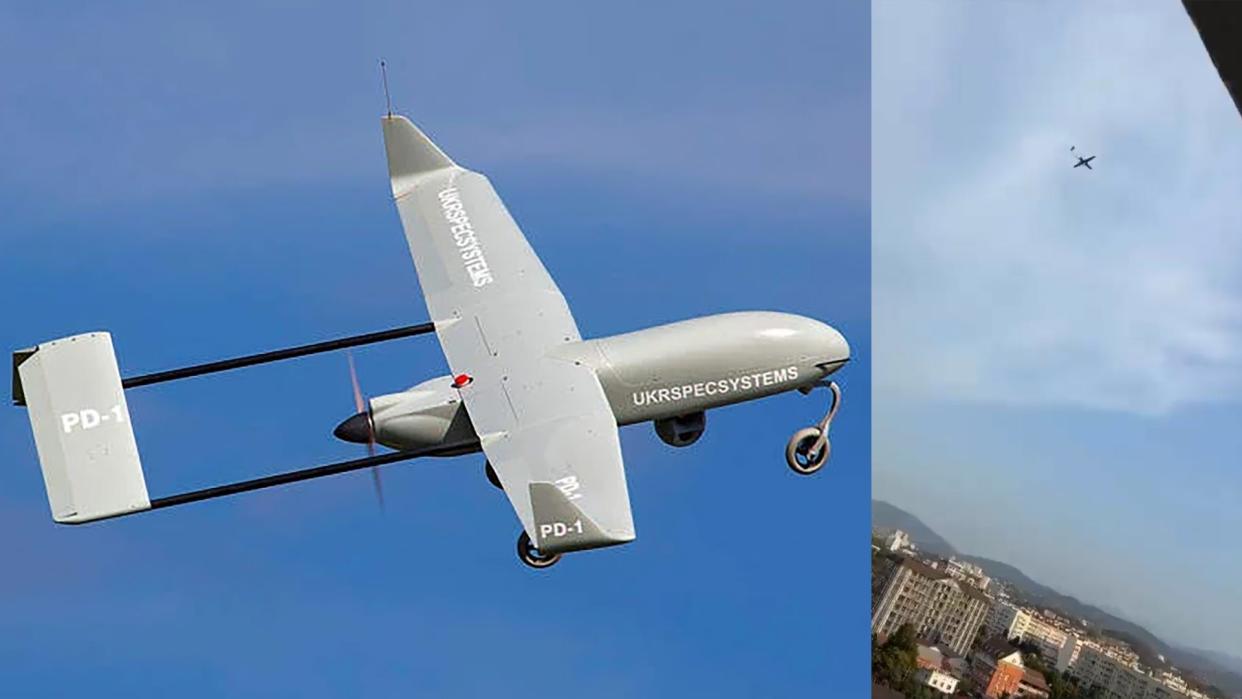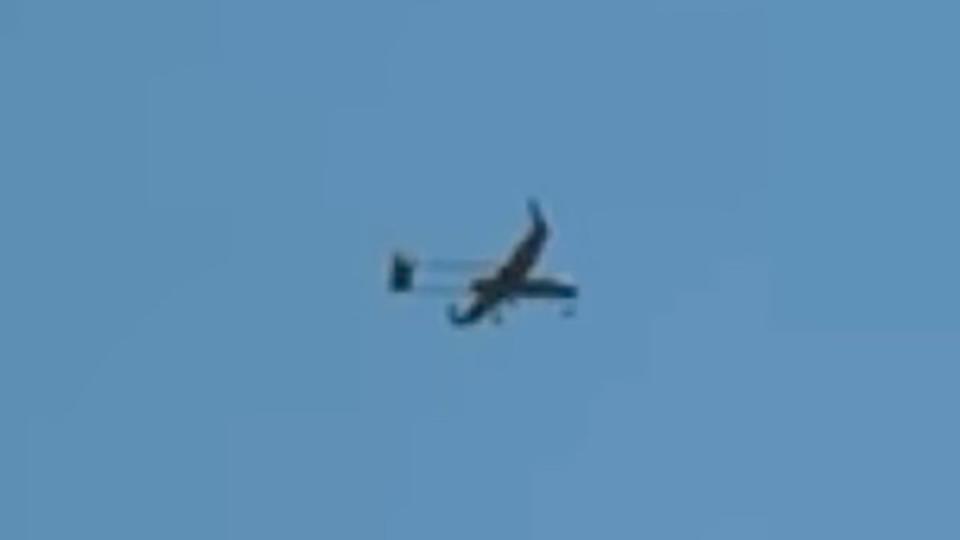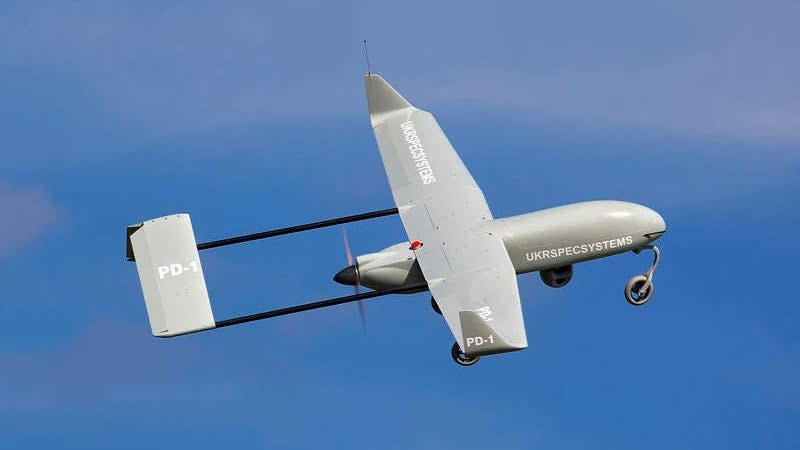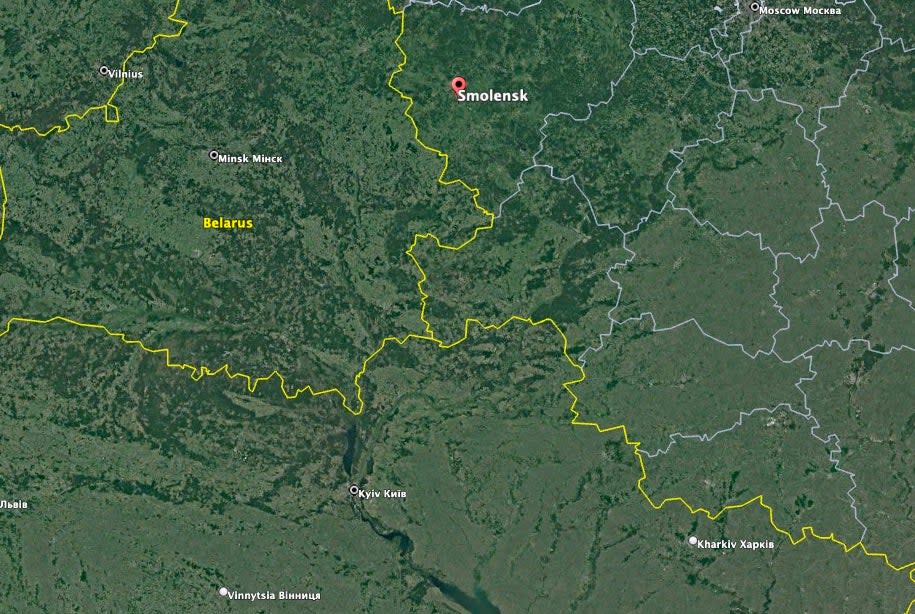Ukraine Situation Report: Long-Range Drones Now Targeting Sochi

- Oops!Something went wrong.Please try again later.
For the second time in less than two weeks, it appears that the Russian resort city of Sochi was targeted by Ukrainian drones. Unconfirmed reports say that the helicopter operating ramp at the international airport there was struck during that attack on Sunday. The War Zone has not been able to verify if that was indeed the case.
Video emerged on social media showing a drone flying over that city - where Russian President Vladimir Putin often visits. Another video shows the drone crashing, creating a ball of fire and a lingering waft of smoke. It is unclear from the videos the extent of any damaged caused.
https://twitter.com/thenewarea51/status/1708424631143600262?s=20 https://twitter.com/maria_drutska/status/1708469174652096991?s=12\u0026t=BQRSNakUKt7_8ssZiGBW-A
The drone seen in the video appears to be a Ukrainian PD-1.



Sochi, located on the eastern shore of the Black Sea, is about 350 miles from the front lines. While a long way for a drone to fly if launched from territory Ukraine controls, it would have to fly through highly defended airspace for hours to get to its target. It's possible, if not probable, the drone took an even longer round over the Black Sea, avoiding Crimean airspace and that over the Sea of Azov. This would put the distance at around 535 miles. The PD-1 drone has a range, at cruising speed, of nearly 600 miles, according to its manufacturer, Ukrspecsystems.

“Ukrainian drones attacked Sochi on October 1, hitting a parking lot of Russian helicopters in the Alder region of Sochi,” the Ukrainian Pravda (UP) news outlet wrote Sunday. “According to UP sources, the Main Directorate of Intelligence (GUR) is behind the attack.”
GUR commander Lt. Gen. Kyrylo Budanov declined comment to us when we asked about the incident. There was no comment from either the Russian Defense Ministry or the regional governor, either. The official Russian TASS news agency said on its Telegram channel only that “a drone was shot down over the Krasnodar Territory. Because of its appearance, six planes that were supposed to land in Sochi were redirected to alternate airfields.”
The incident comes just 12 days after an oil depot in that city was hit by a suspected Ukrainian drone attack, sparking a huge fire.
"The drone fell 25 kilometers (15.5 miles) from Russian President Vladimir Putin's residence in Sochi,” according to Agentstvo, an investigative site launched in 2021.
Veniamin Kondratyev, governor of Russia's Krasnodar region, said on his Telegram channel at the time that a fuel tank caught fire, causing a blaze about 100 square meters in size. No casualties were reported.
https://twitter.com/yarotrof/status/1704391813040087522?ref_src=twsrc%5Etfw%7Ctwcamp%5Etweetembed%7Ctwterm%5E1704391813040087522%7Ctwgr%5E806444f224c4bec8f3fd174e030097bbec350f04%7Ctwcon%5Es1_\u0026ref_url=https%3A%2F%2Fwww.thedrive.com%2Fthe-war-zone%2Fukraine-situation-report-russias-main-defensive-line-breached https://twitter.com/SamRamani2/status/1704433626589409330?ref_src=twsrc%5Etfw%7Ctwcamp%5Etweetembed%7Ctwterm%5E1704433626589409330%7Ctwgr%5E806444f224c4bec8f3fd174e030097bbec350f04%7Ctwcon%5Es1_\u0026ref_url=https%3A%2F%2Fwww.thedrive.com%2Fthe-war-zone%2Fukraine-situation-report-russias-main-defensive-line-breached
While Budanov declined comment about the Sochi drone incident, the GUR did take credit for another drone attack in Russia on Sunday, this one on the Smolensk Aviation Plant. The GUR claimed that attack disrupted the production process of Kh-59 missiles.
“According to confirmed data, three out of four drones hit the target, causing significant damage to the production facilities of the military enterprise of the aggressor state,” the GUR said on its website.
Smolensk is about 200 miles north of the Ukrainian border. The GUR did not specify what type of drones it used in the attack.

The Russian Defense Ministry (MoD) and the regional governor, however, claimed the drones caused no damage.
“An attempt by the Kyiv regime to carry out a terrorist attack by an aircraft-type UAV on objects on the territory of the Russian Federation was stopped,” the Russian MoD said Sunday on its Telegram channel. “Three Ukrainian unmanned aerial vehicles were destroyed by air defense systems on duty over the territory of the Smolensk region.”
The Kh-59 has been used to attack many types of targets in Ukraine.
“Chernihiv, Sumy, Kharkiv, Dnipropetrovsk, Zaporizhzhya and Kherson regions suffer the most from the use of such weapons,” GUR said.
https://twitter.com/front_ukrainian/status/1708737330608058693?s=20
The systemic targeting of Sochi is an interesting revelation. The Russian president has a special affinity to the resort city and it is Russia's premiere warm-weather resort destination in the Summer. It also famously hosted the 2014 Olympics and Russia invaded Ukraine shortly after that event. With these factors in mind, it makes sense that Ukraine would add it to its list of target areas designed to disrupt Russian day-to-day life and bring the war home to the Russian populous. While it is unclear what exactly was being targeted in Sochi on Sunday or if anything was actually damaged, another Ukrainian drone strike in less than two weeks has to jangle nerves there.
As Budanov told us, these attacks are designed to wear down Russia's ability and will to fight and to discredit Russia's air defense systems on the world stage.
"It undermines the belief of the population in an all-powerful Russian regime that is the strongest one in the world," Budanov said in an exclusive interview during his recent visit to D.C. "They start asking those logical questions, like: "where's our air defenses that are supposed to protect us?" And they start blaming their authorities for that, for stealing all the money. The next aspect is strikes against critical military infrastructure. It includes oil refineries that supply fuel to the warfighting as well as the factories and plants that produce components for military equipment. So that’s the overall picture." Budanov continues, "And from the political standpoint, we're also demonstrating the obvious inability of Russian air defense systems, which respectively makes them less lucrative on the world arms markets."
Before we head into the latest from Ukraine, The War Zone readers can catch up on our previous rolling coverage here.
The Latest
Little has changed on the battlefield over the past 48 hours, with neither Ukrainian or Russian officials reporting any significant territorial gains or losses. The intensity of the fighting, however, remains high.
Here are some key takeaways from the latest Institute for the Study of War assessment.
Russian forces are conducting tactical counterattacks in the Robotyne area as part of their elastic defense against ongoing Ukrainian offensive operations in western Zaporizhia Oblast. The situation south of Robotyne is fluid as some tactically significant field fortifications have changed hands several times.
Russian forces continued offensive operations along the Kupyansk-Lyman line, near Bakhmut, along the Avdiivka-Donetsk City line, in the Donetsk-Zaporizhia Oblast border area, and in western Zaporizhia Oblast and marginally advanced in western Zaporizhia Oblast.
https://twitter.com/TheStudyofWar/status/1708973247935430790
Two days after Congress passed a last-minute stop-gap spending bill with no new aid for Ukraine, the White House on Monday announced that it will be sending more aid to Ukraine “soon.”
“There is [a] strong, very strong international coalition behind Ukraine. And if [Russian President Vladimir] Putin thinks he can outlast us, he’s wrong. He’s wrong. And so we will have another package of aid for Ukraine soon to signal our continued support for the brave people of Ukraine,” White House spokesperson Karine Jean-Pierre said during a press briefing, Politico reported. The publication added that the latest aid package will come later this week, according to a U.S. official.
The White House aid announcement comes amid concerns at the Pentagon that it will not be able to send weapons to Ukraine much longer if Congress does not provide additional funding.
The Defense Department still has $5.4 billion worth of weapons available to send to Ukraine, but is fast running out of money to replenish its own stockpiles, two U.S. officials familiar with the discussions told Politico. Without those funds, transfers of weapons may be curtailed due to U.S. stocks dropping below critical contingency levels with no planned replacements clearly delineated. This comes as there are growing angst over the cost of sending more weapons to Ukraine in some U.S. political circles.
https://twitter.com/TodayOnGlobe/status/1708908420366057734
Ukraine will receive 10 Australian-made Slinger counter-drone systems in 2023, the Australian ABC.net news outlet is reporting.
The publication claims they will be delivered under a future U.S. military aid package “by the end of the year.”
Produced by the Australian EOS defense technology firm, the Slinger was designed “based on lessons from conflict regions like Ukraine.”
The lightweight, mobile system marries a Bushmaster M230LF 30 x 113mm cannon — similar to that used on the AH-64 Apache and other platforms — with special rounds that are designed to counter airborne targets like drones. It fires “lightweight 30mm Proximity Sensing Ammunition with radio frequency proximity-fuzed, high explosive fragmentation rounds,” according to EOS. That ammunition is designed to produce a wider kill radius than standard rounds.
The result, according to the company, is a system that can defeat drones for far less money than it takes to shoot them down at close ranges with short-range missiles or other guided weapons.
When we asked the Pentagon about the reported Slinger delivery timeline, a spokesman told us that he didn't “have any security assistance announcements to make today and it would be inappropriate to speculate on the contents of future packages.”
https://www.youtube.com/watch?v=JrJcAOa4pes
In an interview with Radio Free Europe/Radio Liberty, the general director of Turkey’s Baykar Makina arms manufacturer hinted that his company may provide Ukraine with its advanced Akinci drone.
“As for Bayraktar Akinci, this issue is under consideration, as far as I know,” Halyuk Bayraktar told the publication. “...we can fully produce Bayraktar Akinci. We have permission for this from our government, which demonstrates how close we are to implementation.”
Ukraine, he added, “is the first country that has such permission. Defense cooperation requires state permits, and we have this permit. Therefore, the issue regarding Akinci is under consideration.”

The Akinci drone flies at a maximum altitude of between 30,000 and 40,000 feet with a maximum speed of up to 195 knots, has a payload capacity of 1,500 kg (more than 3,300 pounds) and can launch a wide array of smart munitions, including ones with standoff capabilities. It can also be equipped with multi-purpose AESA radar as well as other sensors and loiter for up to 24 hours, according to the company. It is a major step-up from the lighter and simpler TB-2 drone that was very pronounced in its effectiveness in the opening phases of the all-out invasion, but has since been significantly curtailed overall as a result of Russian air defenses.
https://twitter.com/jimdave2012/status/1708924212591669413
Russia is apparently turning to a 63-year-old amphibious aircraft to counter the modern scourge of Ukrainian uncrewed surface vessels.
“In recent weeks, the Naval Aviation component of Russia’s Black Sea Fleet has assumed a particularly important role in the Fleet’s operations as it struggles to deal with concurrent threats on the southern flank of the Ukraine war,” the U.K. Defense Ministry said in its latest assessment. “Naval Aviation is emphasizing maritime air patrol operations, highly likely with a primary mission of the early identification of uncrewed surface vessels. A key Russian asset in these operations is the Be-12 MAIL amphibious aircraft, designed in the 1950s, flying out of bases in occupied Crimea.”
https://twitter.com/DefenceHQ/status/1708713373964132794?s=20
The vast majority of the Be-12s built were used for anti-submarine warfare, as well as search and rescue and other patrol duties.
Ukraine, of course, has no submarines. However, the Be-12’s abilities, even just as a visual observation platform, could make it a useful for spotting small, low-profile, highly maneuverable craft like Ukrainian USVs.
https://youtu.be/aep2D3TexFI?t=24
In 2022, six months after the full-on invasion began, we wrote a deep dive on the Be-12 and how Russia continues to use them in Crimea. You can check that out here.
A leaked document obtained by Politico seems to indicate that Biden administration officials are far more worried about corruption in Ukraine than they publicly admit.
According to the publication, the “sensitive but unclassified” version of the long-term U.S. plan “lays out numerous steps Washington is taking to help Kyiv root out malfeasance and otherwise reform an array of Ukrainian sectors. It stresses that corruption could cause Western allies to abandon Ukraine’s fight against Russia’s invasion, and that Kyiv cannot put off the anti-graft effort.”
“Perceptions of high-level corruption” the confidential version of the document warns, could “undermine the Ukrainian public’s and foreign leaders’ confidence in the war-time government.”
That’s starker than what the State Department published in a public version of the 22-page document, Politico noted.
https://twitter.com/shashj/status/1708826884602302825
In an opinion piece for The Telegraph, former British Defense Secretary Ben Wallace said “Ukraine’s counteroffensive is succeeding,” but that Kyiv needs to recruit more young troops to counter massive Russian conscription.
“Ukraine can also play its part,” wrote Wallace. “The average age of the soldiers at the front is over 40. I understand President Zelensky’s desire to preserve the young for the future, but the fact is that Russia is mobilizing the whole country by stealth. Putin knows a pause will hand him time to build a new army. So just as Britain did in 1939 and 1941, perhaps it is time to reassess the scale of Ukraine’s mobilization.”
Wallace also said that before he left his post, he asked Prime Minister Rishi Sunak to dramatically boost funding for Ukraine.
“I asked the PM to match or increase the £2.3 billion ($2.78 billion) pledged to Ukraine this year, to add to the £4.6 billion ($5.57 billion) we have spent already,” he wrote. “The UK is no longer the biggest European donor – Germany is.”
https://twitter.com/kyivpost/status/1708735188870570297?s=12\u0026t=BQRSNakUKt7_8ssZiGBW-A
The Ukrainian 28th Brigade released a wild video showing its troops in a fire suppression operation near Bakhmut. Running through the woods to the end of a tree line, one soldier jumps in a dugout and lays down fire from his rifle while another soldier stands and delivers several rocket-propelled grenade rounds at Russians in a tree line on the other side of an open field.
https://youtu.be/NNup3KokugU?t=213
Germany announced Monday it has delivered two more Wisent 1 MC tactical mine clearing vehicles to Ukraine, for a total of 10 so far.
Based on the Wisent 1 armor recovery vehicle, the mine-clearing variant has a full-width mine plow, a lane-marking system, a magnetic signature duplicator, a crane with 30-ton lifting capacity and a front-mounted high-lift adaptor.
https://twitter.com/front_ukrainian/status/1708494391386521775?s=20
Days after a Ukrainian attack that destroyed two Russian 2S9 Nona 120 mm self-propelled mortars, a Russian soldier returns to the scene and describes the carnage.
https://twitter.com/UKikaski/status/1708058824781770900?s=20
And finally, we've seen all kinds of weapons in this war, but Ukraine has designed one not just to destroy, but to insult while doing so. It's a Putin bust-shaped drone munition dubbed the "exploding Putin dildo of consequence." Its streamlined penis shape is packed with explosives and shrapnel and delivered by first-person video drone as a loitering munition.
https://twitter.com/saintjavelin/status/1708509429425926208?s=20
That's it for now. We'll update this story when there's more news to report about Ukraine.
Contact the author: howard@thewarzone.com

